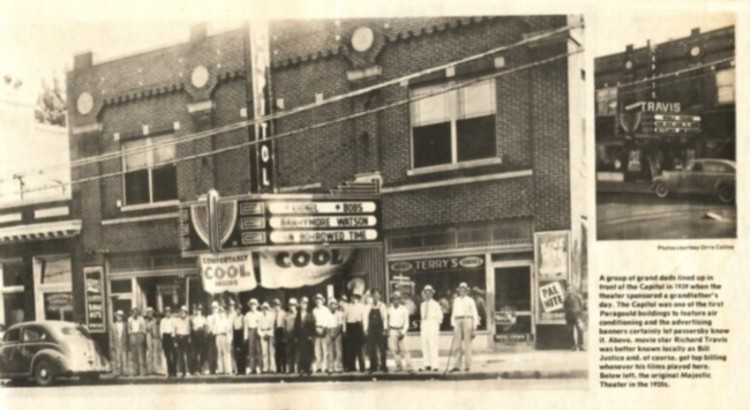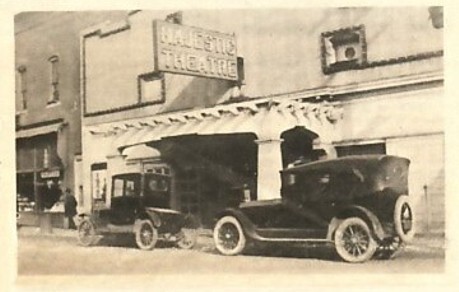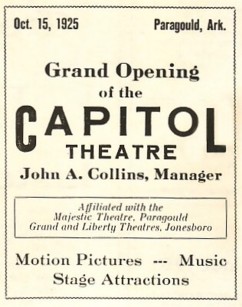I'm sure it would recall the faces of
many people during Depression that
came to the theater to escape the reality of the world for a few short hours by seeing silent movies, vaudeville
acts, musical numbers and stage
shows. It would remember the first
"talkie" and the excitment of the crowd as it waited for the newest development in the entertainment field.
These were the days when the movie theatre was a special place to go.
The Capitol Theatre was built by
Bertig Realty Co. and its grand opening was Oct. 15, 1925. My father, John A. Collins, was named manager.
The feature for the opening night was a silent film, "The Coast Folly," starring Gloria Swanson. The program consisted of Norma Mad-dox as the Queen of Amusement. Her assistants included: Louise Ford as Queen of Music; Virginia Ellis as Queen of Motion Pictures; Isabelle Ellis as Queen of Vaudeville and Jean Light as Queen of Spoken Drama. The Queen's Entertainer was Ernie Futrell, who presented a solo dance.
In 1936, the Collins family purchased the Capitol and became the sole owners-operators.
Vaudeville acts and stage shows, as
well as silent movies, frequented the
Capitol in the late 1920s and early
1930s. There were three theatres in
northeast Arkansas equipped with stage and orchestra pit for vaudeville acts and stage productions, They were the Empire Theatre in Jones-boro, the Home Theatre in Blythe-ville and our own Capitol Theatre here in Paragould.
Some of the well-remembered vaudeville acts included: Edgar Bergen, Yodeling Jimmy Rogers, Tex Ritter, Roy Acuff, Ernest Tubb, Smiley Burnett, Cliff Edwards and Ukulele Ike, Lash LaRue and Johnny Downs and Mary Karnman, members of the original "Our Gang" series.
In 1930, a flood relief benefit show
featured Will Rogers and Captain Frank Hawks. Aaron Massengill's barber shop was located in the Vandervoort Hotel at this time, and I'm sure an unforgettable event in his life was the day he gave Will Rogers a shave.
I guess one of our biggest shows would have been George White's Scandals. This show was advertised to be some-what risque. It had played in Memphis and was booked to play in Jackson, Miss. However, the city fathers of Jackson would not allow them to present their show in that city; therefore, the Capitol got the booking.
I remember when word got around that George White's Scandals were
coming to the Capitol, three boys from Jonesboro A&M College (now Arkansas State University) came and bought out the first 10 rows of seats.
You should have seen the size of that production when they arrived. There were two baggage cars full of scenery alone. There were 125 cast members, 22 stage hands and a full orchestra. We recruited 10 stage hands of our own to assist in handling the scenery. Among these stage hands was Herbert Sanderson, who later became mayor of Jones-boro. On particular piece of scenery was so heavy we used reinforce-ments to keep it from pulling in the roof. The show starred Nora Bayes and Eugene and Willie Howard, who later became well-known Broadway stars.
Needless to say, the house was sold out.
During this era, silent films such as
"The Sheik" with Rudolph Valentino,
"Don Q" with Douglas Fairbanks and "The Gold Rush" with Charlie Chaplin were run. Of course, we had our organist playing for the films. The organists for this era included Carrie Causey, Emily Gernand and Don Hovey. The organist would usually be spotlighted and play a musical variety before the feature would begin.
Our advertising consisted of bill-
board posters called "24 sheets,"
placed on the side of the Capitol building. A-frame billboards with a sheet on each side would be all up and down Pruett Street. Handbills were distributed, ads taken out in the newspaper and ads put on the side of napkin holders in restaurants, all announcing that week's showing.
The movie changed every two days, and admission was 25 cents for night showings and 15 cents for matinees. In 1934, the Capitol got its first pop-corn machine. It was the only concession and sold for 5 cents a bag.
I must tell you about our weekly
publication, "Cinemag." It was start-
ed May 6, 1938. It was a free paper printed by a hand-fed press on Thursday nights, to be ready for

A group of grand dads lined up in front of the Capitol in 1939 when the theater sponsored a grandfather's day. The Capitol was one of the first Paragould buildings to feature air conditioning and the advertising banners certainly let passersby know it. Above (right), movie star Richard Travis was better known locally as Bill Justice and, of course, got top billing whenever his films played here. Below , the original Majestic Theater in the 1920s. Photo courtesy: Orris Collins

|
|
| distribution on Friday. John Rainey
was the printer for the "Greene County Citizen" and he did our printing for us. Editor was Hugh Ketchum. Features of "Cinemag" included a weekly chatter column by Margaret Donaldson giving highlights of goings- on around town. J.T. Hale was said to nbe her ace reporter. There was "Opery Chat, " presenting the latest news about movie stars and their new pictures, coming direct from the studios four days ahead of news releases. Every two weeks or so, we would have a guest editorial entitled, "What Interest Me Most About Paragould." The first guest editor was William A. Kirsch. Another feature was "Micro- phobia," a column for radio fans list- ing programs of interest on KBTM. Local businesses would advertise in "Cinemag." At the bottom of each ad, someone was named for a free pass to the current showing at the Capitol. We had what were known as "Cinemag Boys" deliver the paper. In return, they received free passes to the movie. Even though it was a local publication, many stars subscribed to it. We have photos of such stars as Fred MacMurray, Mickey Rooney, Abbott and Costello, Dick Powell and others reading our publication. Late in December, 1941, we were proud to present the world premiere of "The Man Who Came to Dinner," starring Paragould's own, Bill Justice -- known in Hollywood as Richard Travis. The film also starred Bette Davis, Ann Sheridan and Jimmy Du- rante. Richard Travis came back to Paragould for the premiere. Richard -- or Bill, as we knew him -- had been one of our employees and was the edi- tor of "Cinemag" when he lived here. The Capitol had "Pal Night" on Tuesdays and "Bank Night" on Wed- nesdays. "Pal Night" was simply two for the price of one. "Bank Night" in- volved signing up and receiving a number. Sometime during the show, a number was drawn and if it was your number, you won the amount of money offered in the pot. During this time, Walter Cole was constructing Kings-way. His number was drawn one night and he won $100. I remember his comment was that now he could put in the dance floor at Kingsway. The Capitol was used not only for entertainment purposes but for com- munity projects and patriotic events as well. During World War II, a war bond rally was held there. One would buy a war bond from what was known as the victory girl or from the bank and get a free ticket to the movie at the Capitol. When the rally was held, the picture showing was "Across the Pacific" with Humphrey Bogart and Mary Astor. During WWII, I was called by the Army to duty in the Hawaiian Islands. I was gone approximately two years. During my absence, my wife, Frances -- as did many wives whose husbands were serving their country -- took over and operated the Capitol and Magestic Theatres on top of running a household with three children in it. It was a difficult separation but one that gave us both new strangth. In later years, the Capitol was used for the "Belles and Beaus" show, pre- sented by the hospital auxillary, and for many years, if one would bring a canned food with them, they would be admitted free to see the show and the food was given to the Goodfellows group for needy families at Christmas time. The Capitol was even used as a Sunday School classroom during the Depression when the doors of the church were closed. ========================= |
In 1965, the Capitol was
remodeled and remains much the same today. Our current projectionist, Everett Ward, has been with the Capitol since the 1930s. A lot of careful planning, figuring and refiguring went into the preparation of the Sunset Drive-In Theatre. We travelled all over the nation looking at established drive-in theatres getting ideas and adding our own thoughts and designs to them. Dale Hamilton was the contractor who built the Sunset and I think he was almost as proud of it as we were. It opened in late June, 1950. It consisted of a large, well-lit marquee at the entrance of the driveway leading to the box office. Also at the entrance stood a fountain with colored footlights. In addition, we had a concession stand, projection booth, 560 speakers and our screen measuring 60-feet wide. We also had playground equipment, much to the delight of our younger customers. In 1954, our original screen was blown down by a storm. We were closed from June until August when we finally got our new screen, measur-ing 105-feet wide and 70-feet tall -- one of the tallest screens in the state. It was equivalent to a seven-story building. I'm sure many people will remember the marvelous fireworks display the Sunset had every July 4, with the whole town turning out. Hansel Yopp was always in charge of the firework flag, placed at the top of the screen. He wouldn't let anyone else do it. One year, it was time for the flag to be lit for the finale and out came an upside- down American flag. Another celebration at the drive-in was called Anniversary Week, a week- long celebration of the anniversary of the opening of the Sunset. One year, we gave a way a fur-lined bathtub full of groceries. We held 10 or 15 events every night of Anniversary Week, inclu- ding the diaper derby, greased pig contest, sack races and greased pole contest. If you came in your swimsuit, you were admitted free. George Allen Haynes drove in with a purple polka-dot car and was able to fit 19 people into it. He was awarded free admission and a cash prize. For many years, the Sunset was the meeting place for the Easter Sunrise service sponsored by the First Metho- dist Church. The minister, Brother Williford, and the choir would be on the roof of the concession stand with microphones hooked into the speakers so everyone could hear. A piano, played by Wirta Potter, was provided by Otis Jones of Beard's Temple of Music. The evening before the sunrise service, we would place a 30-foot cross atop the marquee with blue spotlights on it, announcing the services for the next morning. The cross and lights stayed there all night. Many political rallies have been held at our drive-in. Political rallies were held not only for local candidates, but state-wide offices as well, with speakers such as Orval Faubus, Dale Bumpers, David Pryor, Joe Purcell, Bill Alexander and, in the summer of 1968, Ralph Ratton, seeking a congressional seat. I am proud of the fact that my family has operated the Capitol Theatre since its opening in 1925. We are still operat- ing it today. Many good times have been had by many people at the Sunset Drive-In Theater as well. Thank you, Greene County, for letting us entertain you. Orris F. Collins
===========================
|
Slivers of ice, serials and singing at the sink In the late 1920s, all of the 1930s and early 1940s, what fun it was to grow up in the "Magic Square" of Paragould, which was bound on the east by South Tenth Street and on the west by 15th Street (now the bypass). West Court Street was on the north and Kingshigh-way on the South. Some of the things we kids did to oc- cupy our time, besides our chores, we- re...go to the movie on "Pal Night" when two could go for the price of one --which was a dime -- and try to con- vince the ticket lady that we weren't 12 years old yet. We also would to to the movie on Saturday to keep up with the serials, which would always end with someone hanging on a ledge, about to drown or catch fire. And the next Saturday, that part probably wouldn't even be in the next serial! We would put on plays in the barns and charge a bobby pin or safety pin and then the customer didn't have one, we would run in the house and get them one. We flew kites made out of the Daily Press with sticks, twine and rags for the tails. Paste was made out of flour and water. Late in the evening, we would sit out under the streetlight on the corner of Main and 12th streets and tell ghost stories until we would get scared and run home. Our parents were usually sitting on the front porch all around the neighborhood. Our dad would have a lot of water- melons given to him and we would put them under our beds to keep cool. Whenever there were enough kids or neighbors around, we would eat one. Ice was delivered in the back of an ice truck by Mr. Higgins and we had a card that had the different pounds on it. The card was turned to the pounds of ice you wanted that day and put in the window. We would rush out to the truck hen he chipped off the block and he would give us the slivers. Some- times he would accidentally (?) chip off a big chunk. Heavenly! Comic books were the rage and those who could afford to buy them would pass them on to someone else. Later on, the Hit Parade Songbook was sold and when I would get an extra dime, I would buy one and wash dishes and sing those songs until my mother would ask me to stop for awhile. I knew every word to every song. Our dad, Arthur Pillow, liked to fox hunt and he did so nearly every week- end and during the week if he could. Every once in awhile, a panther would get in with the hunt and the dogs would go wild, not knowing whether to chase the fox or run from the panther. Of course, the dogs were never -- but never -- supposed to catch the fox. The men would hunt until after midnight and then go back to the same place several days later to pick up their dogs. Usually the farmers in the area were nice enough to catch them and pen them up until the owners returned. One time when he was out hunting, the Northern Lights could be seen and, of course, they lit up the whole sky. Papa came home real fast and was so scared. He thought the world was coming to an end. Frank Nash, a notorious gangster who was a cohort with Pretty Boy Floyd, was killed June 17, 1933 in Kansas City, Mo. He was brought to Paragould to be buried at the Linwood Mausoleum, which was just across the street from our house on Kingshighway. When they had his funeral, most of the people stayed in their houses until it was over because it was feared that some more gangsters might attend the service and there would be more shooting. All through this growing up the most influential thing in my life was my good, Christian mother -- who minded her own business and told us to, and who under-stood my ups and downs. I still live within one block of that "Magic Square," and go over there very often. I hope your growing up was as much fun. Dora Pillow Hunter |
